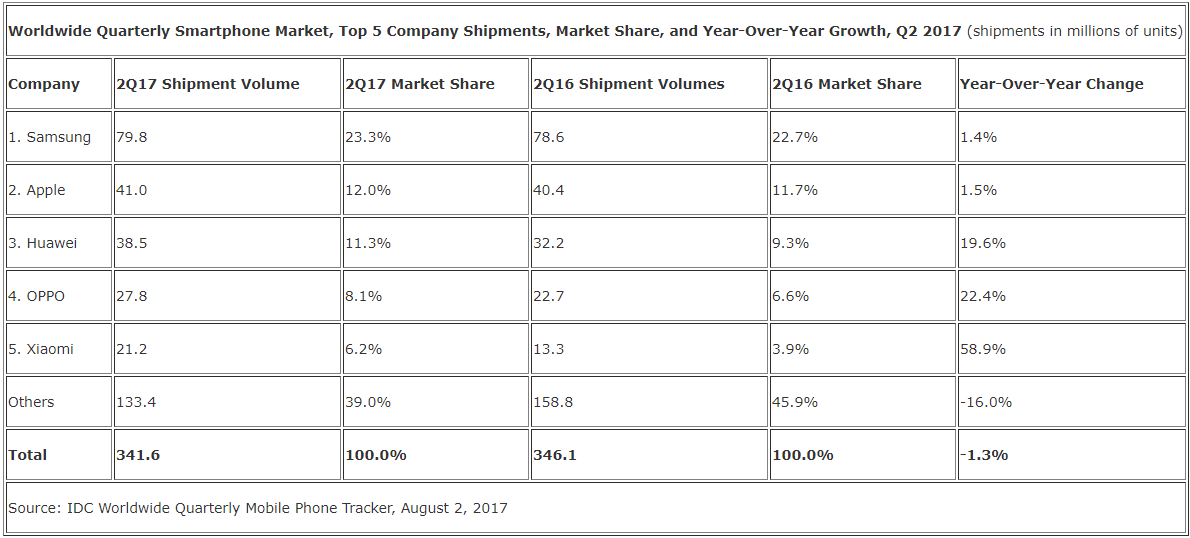Smartphone vendors shipped a total of 341.6 million smartphones worldwide last quarter, down 1.3 percent from the 346.1 million units in Q2 2016. A contraction is a rare enough occurrence in the smartphone market. And yet all five of the top vendors — Samsung, Apple, Huawei, Oppo, and Xiaomi — gained share.
In Q2 2017, the South Korean company once again shipped more smartphones than any other vendor. Samsung’s American counterpart managed to ship just over half of that number, meaning the gap widened between the two. Meanwhile, the Chinese trio, as I like to call them, each shipped more smartphones than a year ago. The Q2 2017 figures come from IDC, which summarized its findings in the following chart:

As you can see above, Samsung’s market share increased 0.6 percentage points (from 22.7 percent to 23.3 percent) as it shipped 1.2 million more smartphones to reach 79.8 million. Every quarter, Samsung owns about a fifth of the market, and that remains true for the first two quarters of 2017. IDC believes consumers are responding well to the Galaxy S8 and Galaxy S8+‘s edge-to-edge displays. And Samsung’s more affordable A Series and J Series continued to perform well in both developed and emerging markets. Now the company just needs a win with the Note8 to put its Note7 fiasco behind it.
June 5th: The AI Audit in NYC
Join us next week in NYC to engage with top executive leaders, delving into strategies for auditing AI models to ensure fairness, optimal performance, and ethical compliance across diverse organizations. Secure your attendance for this exclusive invite-only event.
Apple, meanwhile, gained 0.3 points (to 12.0 percent) with shipments up by some 600,000 units to 41.0 million. Put another way, Apple did not benefit much from Samsung’s woes. Still, the iPhone 7 Plus outperformed the 6S Plus from a year ago. All eyes are now on the iPhone 7s, iPhone 7s Plus, and come September the iPhone 8. For the iPhone 8, a larger AMOLED display, wireless charging, and increased performance are all expected.
Huawei gained 2.0 points (to 11.3 percent), hitting double digits for the first time. Furthermore, the Chinese firm is getting awfully close to Apple, as also pointed out by Canalys earlier today. The company needs to successfully penetrate the U.S. market at the carrier level if it wishes to remain competitive with Samsung and Apple.
Oppo increased 1.5 points (to 8.1 percent) and Xiaomi grabbed 2.3 points (to 6.2 percent). Chinese brands Oppo and Vivo last year pushed out previous fourth- and fifth-place players Lenovo and Xiaomi, but the latter has made a comeback. While the Android and iOS duopoly doesn’t look like it’s going away, the Samsung and Apple duopoly continues to erode as China’s smartphone market matures and local players look to the worldwide stage. Chinese value-packed devices offer the latest features at a fraction of the cost of market leaders Samsung and Apple.
The fact that all of the top five vendors saw positive shipment growth while the rest of the market contracted 16.0 percent shows just how much momentum the leaders have. 2017 is poised to be a rebound year for smartphones, but that doesn’t mean there won’t be losers.
“In my opinion, the biggest change in the second quarter is the size of the contraction among the ‘Others’ outside of the top 5 OEMs,” IDC vice president Ryan Reith said in a statement. “It’s no secret that the smartphone market is a very challenging segment for companies to maintain or grow share, especially as already low average selling prices declined by another 4.3 percent in 2016. The smaller, more localized vendors will continue to struggle, especially as the leading volume drivers build out their portfolio into new markets and price segments.”

